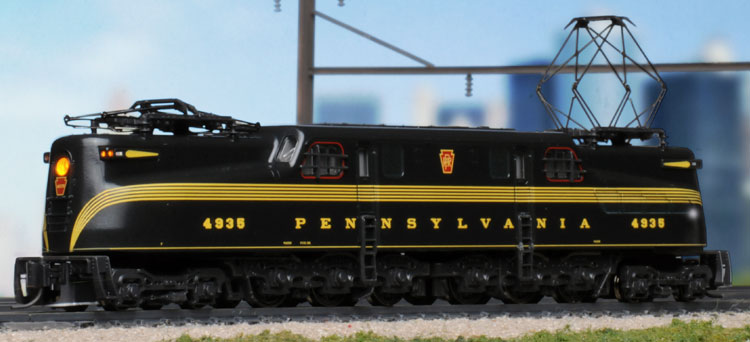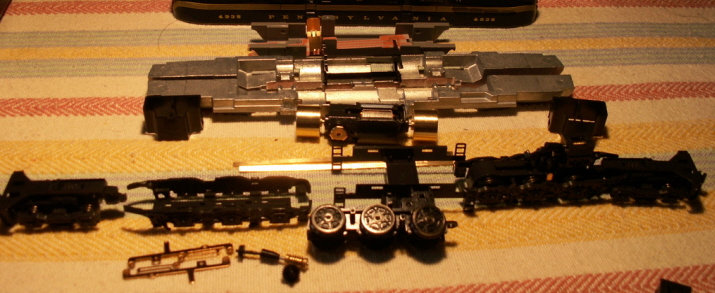

Introduced: 2008 (standard version), 2011 (decoder-equipped version) and 2012 ("American Railroad" version)
Ala their SP GS-4, Kato's PRR GG1 is an absolutely superb model that, unfortunately, is probably going to have a somewhat limited audience (IE, PRR modelers). Oh, that hasn't stopped me from using mine to pull an old Northern Pacific passenger train around my Pacific Northwest logging layout for hours and hours. But I promise you, I felt guilty about it the whole time.
Anyway, it's an amazingly appealing model (and one that I suspect will somehow find its way onto a lot of non-PRR layouts).

The chassis is gigantic, all-metal and split-frame. The motor is an open-sided 5-poler (and not skew-wound). Pickup is accomplished via Kato's traditional system of axle-tip wipers. Vertical metal contacts extend from the trucks and in turn transfer current to metal strips on the chassis (said strips being held in place by the plastic piece with the four ladders on it). Five of the six wheels on the center trucks provide pickup (with each truck having a traction tire equipped wheel). The pilot and trailing trucks are connected to the center trucks, but they do not provide pickup (or propulsion). All six axles on the center trucks are geared (with all gearing being plastic). Directional lighting is provided by a PC-board on top of the chassis (with light tranferred around via large chunks of light-conducting plastic inside the shell). The couplers are Kato's proprietary automatic knuckles (mounted to the pilot and trailing trucks). Both the pilot and trailing trucks are sprung (IE, the truck assembly provides downward pressure to help keep the trucks from derailing). The pantagraphs do not conduct current, nor are they sprung (although they do move up and down). Tiny driveshafts run from the flywheels directly into the trucks (and be careful with those trucks - they pull off with very little effort, and the driveshafts are easy to lose).
Performance is nothing short of sensational. These models run absolutely smoothly and quietly. Pickup is flawless, throttle response is perfect, and slow speed creep is exceptional. The top-end speed seems a bit higher than necessary, but that's never been a big issue for me. The flywheels are particularly affective on this model, making for a nice slow glide once you cut the throttle. Pulling power is impressive. I had no problems with mine derailing.
These models will run on very narrow radius curves (9.75"). However, they look pretty silly doing so (with the ends hanging out at ridiculous angles). They will probably look their best on 19"-radius curves or broader.
So, yep, definitely another home-run for Kato. And, can you hear that? That's the sound of thousands of old Arnold GG1's being packed away and stored forever.
To remove the shell, first unclip the plastic ladder assembly from either side. Then, insert some toothpicks between the chassis and the window inserts to free the chassis from the shell (the chassis contacts are under each of the four cab windows). Note the two clear plastic pieces that route light from the LEDs to the shell - they're loose fitting and will probably pop off somewhere during this whole process. Fortunately, there's really only one way to put them back correctly, so I'm sure you'll eventually figure it out (if I can, anybody can).

Here's what Kato has to say about them -
The GG1, one of the PRR's most famous and recognizable locomotives, is also one of the most curiously designed. Technically two locomotives under one shell (a "G" class locomotive is a 4-6-0 by PRR specification, therefore the GG1 was two "G" locomotives in a 4-6-0:0-6-4 arrangement). This added up to a 4.6k horsepower locomotive that was staggeringly powerful, even by today's standards. Designed in the 20's, built in 30's, and not retired until the 80's, the GG1 had an incredible lifespan (even when they were cut in two and run as GG's) and survives today as a testament to its time in both its unique Loewy-design and overwhelming performance.
Features -
- Designed to accompany the Kato Broadway Limited passenger train
- Blackened metal Pantographs
- Able to go through an 249mm (9.74") radius S-Curve
- Shock absorber construction gives even traction and performance, even on the roughest track
- Powerful mechanism able to pull a full 15 car Broadway Ltd. Consist up a 4% grade
- Illuminated + Directional Class lights, headlight, and number boards
- DCC Friendly, can take any DCC decoder designed to work with our N scale SD40-2 Mid production
Trivia - In 2011, Kato's "Kobo Customs" division released a number of GG1's with preinstalled decoders (TCS K1D4-NC's). 2012 saw the release of an "American Railroad" version of the GG1 (also a Kobo Custom). This model has redesigned blower ducts that are elevated higher and to the rear of the locomotive number boards. Prototypically speaking, this was done later in the GG1's lifetime to reduce the amount of debris that would be sucked into the locomotive as a result of the low body placement. Kato's Kobo Custom models are built to order by "some guy" in Japan (IE, not mass-produced), so the numbers are quite limited.

Grade: A
Reviewed 01/09 Model Railroader: ("This N scale Kato model accurately captures all the curves of the Raymond Loewy-streamlined carbody and has a smooth and powerful mechanism to boot. The dimensions of the model match those of drawings in the October 1994 issue of Model Railroader. It is decorated in the modified-Loewy paint scheme introduced in 1941. The model's Brunswick green paint is the correct almost-black shade, and the serif Clarendon lettering font is appropriate for this era, as is the red pinstriping around the cab windows. The placement of the lettering, heralds, and striping matches prototype photos. The lettering on the model is bright yellow in color. To match the prototype all lettering should be gold leaf. Later GG1 paint schemes used a dark yellow-gold shade called "Synthetic Buff."
"The side grills are especially well done. Separately applied details include cab ladders and window safety bars. The non-functioning blackened metal pantographs raise and lower easily. When fully extended the pantographs are 25 N scale feet (17/8 inches) above the railhead. The can motor with two brass flywheels is housed inside a split die-cast metal frame. Universal shafts transfer power to a gearbox attached to each three-axle section of the articulated frame. All six driving axles are powered. All wheels are blackened metal, and the drive wheels measure a scale 41" in diameter. The articulated frame and the idler truck sideframes have sharply molded details that match the prototype. Our review sample had one traction-tire-equipped driver. The model's drawbar pull was equivalent to 24 free-rolling N scale passenger cars on straight and level track. The GG1 should have plenty of power to pull the new 14-car Kato N scale Broadway Limited passenger train. Converting the GG1 to DCC is easy.
"The model's forward headlight, illuminated number boxes, and class lights came on at 2 volts. All lighting is directional. When I flipped the direction switch, the front headlight, number boxes, and class lights went dark, and the rear set of lights illuminated. Automatic directional lighting wasn't a feature of the prototype. All lighting is from light-emitting diodes (LEDs) that have an orangish cast. The class lights would look more prototypical if they were white or green. At 2 volts the model rolled steadily at only 0.8 scale mph. The GG1 accelerated to 200 scale mph at 12 volts, double the top speed of the prototype. A more prototypical 100 scale mph top speed is achieved at 8 volts. The Kato GG1 ran smoothly through turnouts and around a 9�" curve. However, the model looks much better on broader curves, especially when pulling passenger cars. Despite its yellow lettering, the model looks great hauling the Kato Broadway Limited. The Kato GG1 is a good choice for N scalers who want to model the Pennsy's electrified territory. Price $139")